Studies on Glucagon Receptor and Antagonists of Glucagon Receptor for the Management of Diabetes Mellitus
CURRENT RESEARCH IN DIABETES & OBESITY JOURNAL JUNIPER PUBLISHERS
Authored by Ghulam Abbas
Abstract
Glucagon receptor plays an important role in the glucose homeostasis and thus is drug target for the management of hyperglycemia in type-2 diabetes mellitus. The suppression of glucagon secretion from the alpha-cells is the key to control hyperglycemic condition. The identification of non-peptide antagonists of glucagon receptor is an effective therapeutic approach to inhibit the glucagon secretion to achieve normal glucose index.
Keywords: Glucagon receptor; Hyperglycemia; Diabetes mellitus; Antagonists
Introduction
Background
Diabetes mellitus is a chronic metabolic disorder which is spreading at an alarming rate all over the world. Glucagon receptor belongs to the G protein-coupled receptors (GPCRs) superfamily and an important drug target for type-2 diabetes [1]. G-Proteins (guanine nucleotide binding proteins) actually act as molecular switches to turn on intracellular signaling as a result of GPCRs activation by intracellular stimuli. The GPCRs are also known as membrane bound receptors [2,3].
Both rat and mouse glucagon receptors are composed of 485-amino acids while the human glucagon receptor contains 477 amino acids (62kDa) and seven transmembrane (7TM) domain proteins [4]. The human glucagon receptor is little shorter and about 80% identical to the mouse receptor. The structure-function studies revealed that all seven transmembrane helices are essential for the process of receptor folding and transporting to cell surface. Moreover, it is observed that the pattern of glycosylation may have a critical role in ligand recognition. Hence, for ligand binding, extracellular portion (intact N-terminal) of the receptor is required. It is found that carboxyl-terminal tail is not involved in the ligand binding however it is necessary for desensitization and internalization [5-7].
Glucagon peptide and its biological action
Glucagon is a peptide hormone composed of 29-amino acids which is produced and secreted in the α-cells of the islets of langerhans in order to maintain normal glucose index by producing hepatic glucose to regulate insulin action [4]. The amino acid sequence of glucagon peptide is shown in Figure 1.
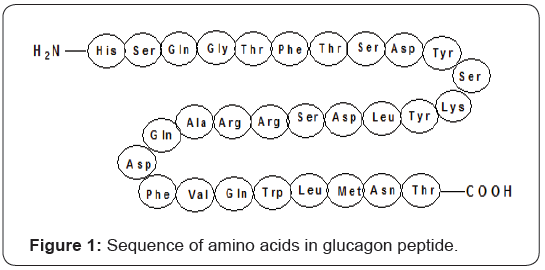
Glucagon exerts its effects generally in the liver, where it stimulates the biological events such as glycogenolysis, gluconeogenesis, and ketogenesis to raise hepatic glucose output. Cyclic adenosine monophosphate (cAMP) actually mediates most of the glucagon’s cellular effects. During this process glucagon receptor binds with glucagon peptide to activate adenylyl cyclase via its cognate heterotrimeric G protein Gs to produce cAMP as shown in Figure 2 [4,6,8].
Antagonists of glucagon receptor
The production and release of large quantity of glucose from the liver under the action of glucagon receptor is a major cause of hyperglycemia in type- 2 diabetes. During type- 2 diabetes, the level of glucagon is higher than both the insulin and blood glucose levels. In this situation, one of the most effective strategies for the treatment of hyperglycemia in type- 2 diabetes involved development and discovery of new efficient therapeutic agents (antagonists) to block the effect of glucagon on hepatic glucose production [9]. New therapies capable of maintaining normal glucose index for longer period of time without serious side effects are highly desirable [10]. Non-peptide glucagon antagonists of glucagon receptor are valuable because they are orally useful active hypoglycemic agents as body can absorb them properly [11,12].
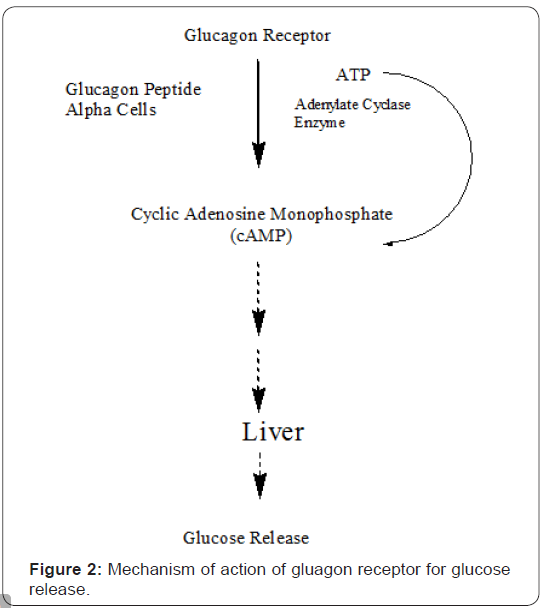
In a study, a series of triarylimidazoles and triarylpyrroles was investigated to discover new non-peptide, orally bioavailabile antagonists of glucagons receptor. Compound 2-(4-Pyridyl)- 5-(4-chlorophenyl)-3-(5-bromo-2-propyloxyphenyl)pyrrole as shown in Figure 3, exhibited significant inhibition against binding of isotopic labeled glucagon to the human glucagon receptor with an IC50= 3.7±6 3.4nM [8].
Similarly, in another study, N-[3-cyano-6-(1, 1-dimethylpropyl)-4, 5, 6, 7-tetrahydro-1- enzothien-2-yl]-2- ethylbutanamide (compound 2) exhibited potent GCGR antagonist potential by inhibiting (IC50 of 181±10 nmol/l) the binding of 125I-glucagon to the membrane. Whereas, its structurally related analog (compound 3) as shown in Figure 4, was a poor inhibitor (20±1.5% inhibition at 10μmol/l) on glucagon binding assay [13]. The fungal bisanthroquinone skyrin was investigated for its inhibitory potential against glucagon-stimulated production of cAMP in vivo. Skyrin exhibited significant inhibition of cAMP production from rat liver. The mechanism of antagonistic effect of skyrin was non-competitive type for binding of glucagon to its receptor instead it specifically uncoupled glucagon receptor for adenylate cyclase activation. Skyrin and its oxygenated derivative oxyskyrin are shown in Figure 5. Skyrin and oxyskyrin inhibited glucagon stimulation of cAMP production with an EC50 =42μmol/L and EC50 =106μmol/L, respectively [14,15].
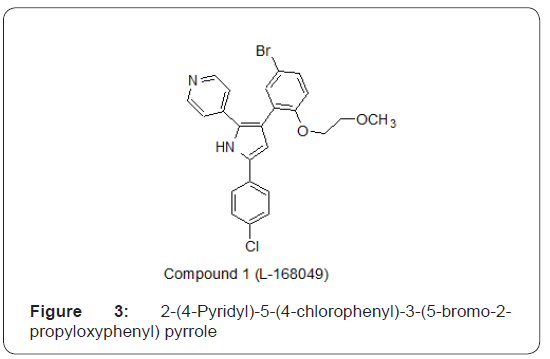
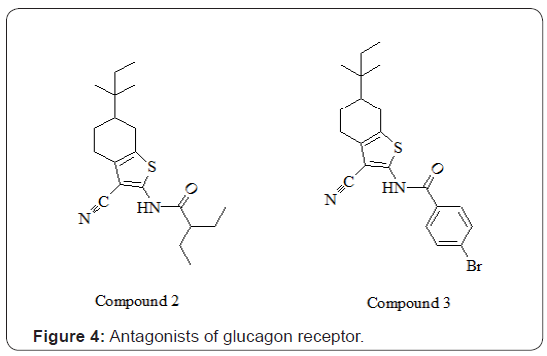
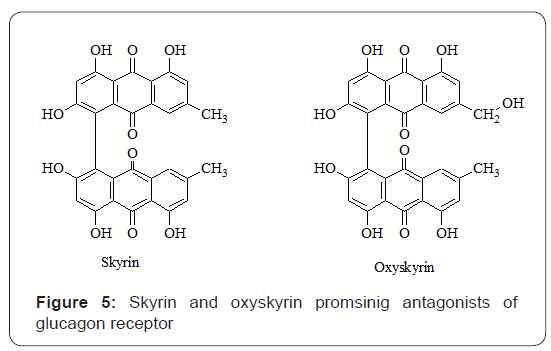
To Know More About Current Research in Diabetes & Obesity Journal Please click on:
https://juniperpublishers.com/crdoj/index.php
To Know More About Open Access Journals Please click on: https://juniperpublishers.com/index.php


Comments
Post a Comment